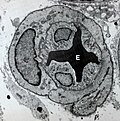Pericyte: Difference between revisions
CSV import |
CSV import |
||
| Line 32: | Line 32: | ||
{{stub}} | {{stub}} | ||
<gallery> | |||
File:Microvessel.jpg|Pericyte | |||
File:Gap_cell_junction-en.svg|Gap cell junction | |||
File:Solitary_fibrous_tumour_intermed_mag.jpg|Solitary fibrous tumour | |||
</gallery> | |||
Latest revision as of 01:09, 18 February 2025
Pericyte
A Pericyte is a type of cell that wraps around the endothelial cells that line the capillaries and venules throughout the body. They are found in close proximity to the endothelial cells and are embedded within the basement membrane of the capillaries and venules.
Structure[edit]
Pericytes are elongated, irregularly branched cells that share the basement membrane with the endothelial cells. They have a central body from which several long processes extend. These processes embrace the capillary wall, providing both structural support and regulation of blood flow.
Function[edit]
Pericytes play a crucial role in the regulation of capillary blood flow, blood-brain barrier integrity, angiogenesis, and clearance of cellular debris. They also have the potential to differentiate into other cell types, such as fibroblasts, macrophages, and myofibroblasts, under certain conditions.
Clinical significance[edit]
Pericyte dysfunction has been implicated in a number of diseases, including diabetic retinopathy, Alzheimer's disease, and cancer. In diabetic retinopathy, pericyte loss leads to the formation of microaneurysms and increased vascular permeability. In Alzheimer's disease, pericyte degeneration contributes to the breakdown of the blood-brain barrier. In cancer, pericytes are thought to play a role in tumor angiogenesis and metastasis.





